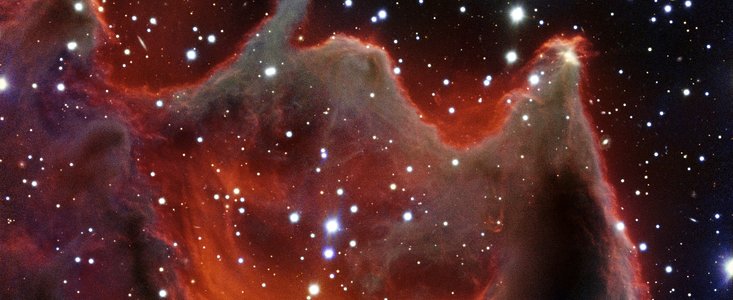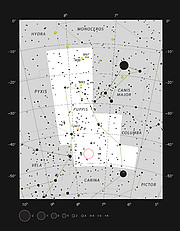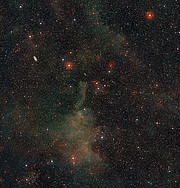Persbericht
De muil van het beest
VLT fotografeert komeetglobule CG4
28 januari 2015
Op deze nieuwe opname van ESO’s Very Large Telescope komt de komeetglobule CG4 over als de wijd opengesperde muil van een reusachtig kosmisch monster. Hoewel hij op de foto groot en helder lijkt, is dit eigenlijk een zwakke nevel, die voor amateur-astronomen maar moeilijk te herkennen is. De precieze aard van CG4 blijft een mysterie.
In 1976 werden op foto’s, genomen met de UK Schmidt Telescope in Australië, verscheidene langwerpige komeet-achtige objecten ontdekt. Vanwege hun uiterlijk werden ze komeetglobulen genoemd, ook al hebben ze niets met kometen te maken. Ze werden allemaal aangetroffen in een enorme wolk van gloeiende gas die de Gumnevel wordt genoemd. Ze vertoonden dichte, donkere, stofrijke koppen en lange, zwakke staarten, die veelal van de Vela-supernovarest, die zich in het centrum van de Gumnevel bevindt, af gericht waren. Hoewel deze objecten relatief dichtbij zijn, hebben astronomen er lang over gedaan om ze te vinden: ze geven maar weinig licht en zijn daardoor moeilijk te detecteren.
Het object op deze foto, CG4, dat ook wel de Hand van God wordt genoemd, is een van deze komeetglobulen. Hij bevindt zich op ongeveer 1300 lichtjaar van de aarde in het sterrenbeeld Puppis (Achtersteven).
De kop van CG4 – het deel dat op deze foto te zien is en op de kop van een reusachtig monster lijkt, heeft een diameter van 1,5 lichtjaar. De staart van de globule – die naar onderen is gericht en buiten beeld valt – is ongeveer acht lichtjaar lang. Naar astronomische maatstaven is dat een relatief kleine wolk.
De vrij geringe omvang is kenmerkend voor komeetglobulen. Alle komeetglobulen die tot nu toe zijn ontdekt, zijn geïsoleerde, relatief kleine wolken van neutraal gas en stof in de Melkweg, die worden omgeven door heet, geïoniseerd materiaal.
De kop van CG4 is een dikke wolk van gas en stof, die alleen zichtbaar is omdat hij wordt aangelicht door sterren in de omgeving. De straling van deze sterren is bezig om de kop van de globule geleidelijk weg te vagen: ze breekt de kleine deeltjes af die het sterlicht verstrooien. Maar de stoffige wolk van CG4 bevat nog genoeg gas voor de vorming van meerdere zonachtige sterren. CG4 is ook daadwerkelijk bezig om nieuwe sterren te vormen, een proces dat misschien in gang werd gezet toen de straling van de sterren die de Gumnevel tot gloeien brengen hem bereikte.
Waarom CG4 en andere komeetglobulen zo’n aparte vorm hebben is nog steeds een punt van discussie onder astronomen. Er bestaan twee theorieën over. Mogelijk waren komeetglobulen, en dus ook CG4, van oorsprong bolvormige nevels die hebben blootgestaan aan een nabije supernova-explosie en daardoor zijn vervormd. Andere astronomen vermoeden dat komeetglobulen hun vorm te danken hebben aan de sterrenwind en de ioniserende straling van hete, zware OB-sterren. Deze effecten kunnen in eerste instantie leiden tot de vorming van bizarre structuren die (heel toepasselijk) olifantslurven worden genoemd, en uiteindelijk tot de vorming van komeetglobulen.
Om meer te weten te komen, moeten astronomen de massa, de dichtheid, de temperatuur en de snelheden van het materiaal in de globulen bepalen. Dat kan door moleculaire spectraallijnen te meten die vooral op millimetergolflengten te vinden zijn – golflengten waarop telescopen zoals de Atacama Large Millimeter/submillimeter Array (ALMA) opereren.
Deze foto is gemaakt in het kader van het ESO Cosmic Gems-programma. Dat is een initiatief waarbij interessante, intrigerende of visueel aantrekkelijke objecten voor educatieve of publicitaire doeleinden met ESO-telescopen worden gefotografeerd. Het programma maakt gebruik van ‘telescooptijd’ die niet geschikt is voor wetenschappelijke waarnemingen. Alle verzamelde gegevens, die ook bruikbaar kunnen zijn voor wetenschappelijke doeleinden, staan via ESO’s wetenschappelijk archief ter beschikking van astronomen.
Meer informatie
ESO is de belangrijkste intergouvernementele astronomische organisatie in Europa en de meest productieve sterrenwacht ter wereld. Zij wordt ondersteund door vijftien landen: België, Brazilië, Denemarken, Duitsland, Finland, Frankrijk, Italië, Nederland, Oostenrijk, Portugal, Spanje, Tsjechië, het Verenigd Koninkrijk, Zweden en Zwitserland. ESO voert een ambitieus programma uit, gericht op het ontwerpen, bouwen en beheren van grote sterrenwachten die astronomen in staat stellen om belangrijke wetenschappelijke ontdekkingen te doen. Ook speelt ESO een leidende rol bij het bevorderen en organiseren van samenwerking op astronomisch gebied. ESO beheert drie waarnemingslocaties van wereldklasse in Chili: La Silla, Paranal en Chajnantor. Op Paranal staan ESO’s Very Large Telescope (VLT), de meest geavanceerde optische sterrenwacht ter wereld, en twee surveytelescopen: VISTA werkt in het infrarood en is de grootste surveytelescoop ter wereld en de VLT Survey Telescope is de grootste telescoop die uitsluitend is ontworpen om de hemel in zichtbaar licht in kaart te brengen. ESO is ook de Europese partner van de revolutionaire telescoop ALMA, het grootste astronomische project van dit moment. Daarnaast bereidt ESO momenteel de bouw voor van de 39-meter Europese Extremely Large optical/near-infrared Telescope (E-ELT), die ‘het grootste oog op de hemel’ ter wereld zal worden.
Links
• Foto’s van de Very Large Telescope
• Foto’s die met de Very Large Telescope zijn gemaakt
Contact
Richard Hook
ESO education and Public Outreach Department
Garching bei München, Germany
Tel: +49 89 3200 6655
Mobiel: +49 151 1537 3591
E-mail: rhook@eso.org
Marieke Baan (Perscontact Nederland)
ESO Science Outreach Network
en NOVA Informatie Centrum
Tel: +31(0)20-5257480
E-mail: eson-netherlands@eso.org
Over dit bericht
| Persberichten nr.: | eso1503nl |
| Naam: | CG4 |
| Type: | Milky Way : Nebula : Type : Star Formation |
| Facility: | Very Large Telescope |
| Instruments: | FORS1 |
Our use of Cookies
We use cookies that are essential for accessing our websites and using our services. We also use cookies to analyse, measure and improve our websites’ performance, to enable content sharing via social media and to display media content hosted on third-party platforms.
ESO Cookies Policy
The European Organisation for Astronomical Research in the Southern Hemisphere (ESO) is the pre-eminent intergovernmental science and technology organisation in astronomy. It carries out an ambitious programme focused on the design, construction and operation of powerful ground-based observing facilities for astronomy.
This Cookies Policy is intended to provide clarity by outlining the cookies used on the ESO public websites, their functions, the options you have for controlling them, and the ways you can contact us for additional details.
What are cookies?
Cookies are small pieces of data stored on your device by websites you visit. They serve various purposes, such as remembering login credentials and preferences and enhance your browsing experience.
Categories of cookies we use
Essential cookies (always active): These cookies are strictly necessary for the proper functioning of our website. Without these cookies, the website cannot operate correctly, and certain services, such as logging in or accessing secure areas, may not be available; because they are essential for the website’s operation, they cannot be disabled.
Functional Cookies: These cookies enhance your browsing experience by enabling additional features and personalization, such as remembering your preferences and settings. While not strictly necessary for the website to function, they improve usability and convenience; these cookies are only placed if you provide your consent.
Analytics cookies: These cookies collect information about how visitors interact with our website, such as which pages are visited most often and how users navigate the site. This data helps us improve website performance, optimize content, and enhance the user experience; these cookies are only placed if you provide your consent. We use the following analytics cookies.
Matomo Cookies:
This website uses Matomo (formerly Piwik), an open source software which enables the statistical analysis of website visits. Matomo uses cookies (text files) which are saved on your computer and which allow us to analyze how you use our website. The website user information generated by the cookies will only be saved on the servers of our IT Department. We use this information to analyze www.eso.org visits and to prepare reports on website activities. These data will not be disclosed to third parties.
On behalf of ESO, Matomo will use this information for the purpose of evaluating your use of the website, compiling reports on website activity and providing other services relating to website activity and internet usage.
Matomo cookies settings:
Additional Third-party cookies on ESO websites: some of our pages display content from external providers, e.g. YouTube.
Such third-party services are outside of ESO control and may, at any time, change their terms of service, use of cookies, etc.
YouTube: Some videos on the ESO website are embedded from ESO’s official YouTube channel. We have enabled YouTube’s privacy-enhanced mode, meaning that no cookies are set unless the user actively clicks on the video to play it. Additionally, in this mode, YouTube does not store any personally identifiable cookie data for embedded video playbacks. For more details, please refer to YouTube’s embedding videos information page.
Cookies can also be classified based on the following elements.
Regarding the domain, there are:
- First-party cookies, set by the website you are currently visiting. They are stored by the same domain that you are browsing and are used to enhance your experience on that site;
- Third-party cookies, set by a domain other than the one you are currently visiting.
As for their duration, cookies can be:
- Browser-session cookies, which are deleted when the user closes the browser;
- Stored cookies, which stay on the user's device for a predetermined period of time.
How to manage cookies
Cookie settings: You can modify your cookie choices for the ESO webpages at any time by clicking on the link Cookie settings at the bottom of any page.
In your browser: If you wish to delete cookies or instruct your browser to delete or block cookies by default, please visit the help pages of your browser:
Please be aware that if you delete or decline cookies, certain functionalities of our website may be not be available and your browsing experience may be affected.
You can set most browsers to prevent any cookies being placed on your device, but you may then have to manually adjust some preferences every time you visit a site/page. And some services and functionalities may not work properly at all (e.g. profile logging-in, shop check out).
Updates to the ESO Cookies Policy
The ESO Cookies Policy may be subject to future updates, which will be made available on this page.
Additional information
For any queries related to cookies, please contact: pdprATesoDOTorg.
As ESO public webpages are managed by our Department of Communication, your questions will be dealt with the support of the said Department.





